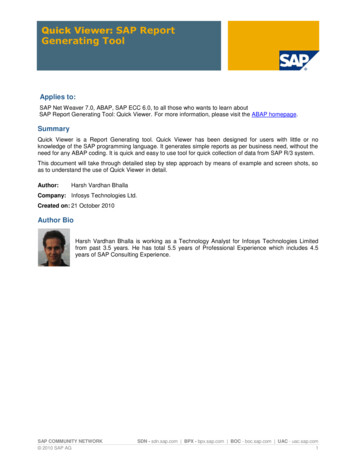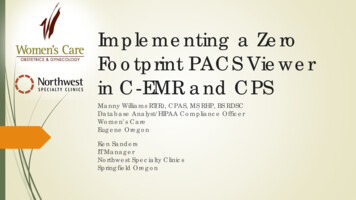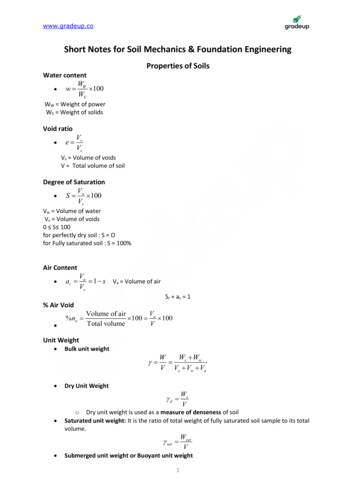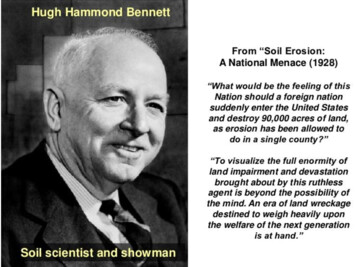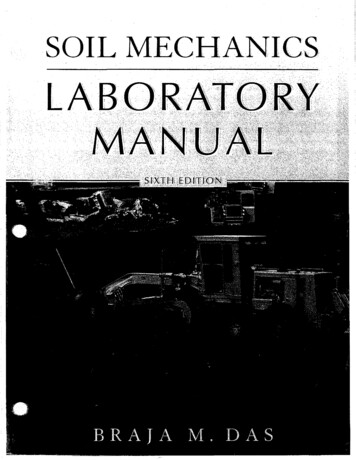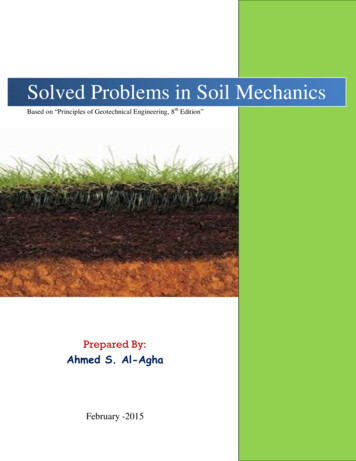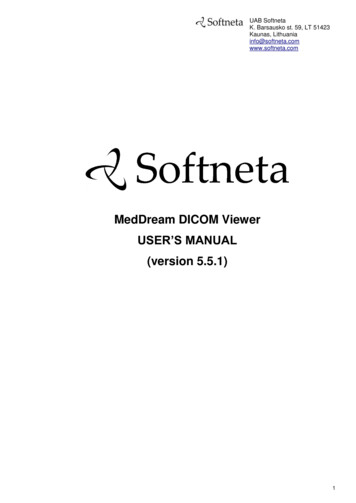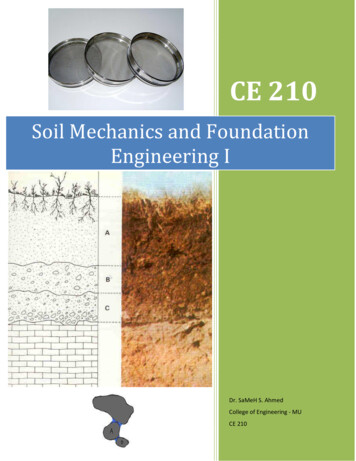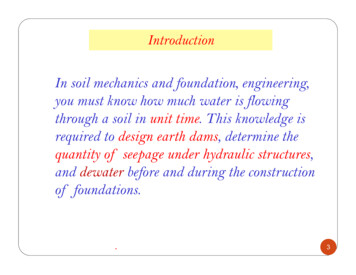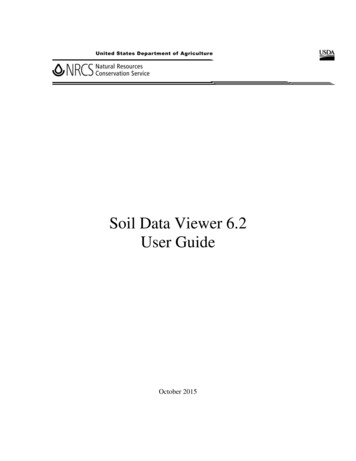
Transcription
Soil Data Viewer 6.2User GuideOctober 2015
Table of ContentsINTRODUCTION . 5WHAT IS “SOIL DATA VIEWER” . 5WHAT CHANGES HAVE BEEN MADE SINCE 6.1? . 5WHAT SOFTWARE AND CAPABILITIES DO I NEED TO USE SOIL DATA VIEWER 6.2? . 5WHAT DATA DO I NEED TO RUN SOIL DATA VIEWER? . 7How do I obtain the soil data needed for Soil Data Viewer?. 7How do I prepare the data needed to run Soil Data Viewer? . 8SOIL SURVEY 101 . 9AGGREGATION .11What is “aggregation”? .11Aggregation Method Descriptions .11Horizon Aggregation .13RUNNING SOIL DATA VIEWER STANDALONE .16APPLICATION STARTUP .16GENERATING AN AGGREGATION REPORT .17GENERATING A MAP UNIT DESCRIPTION REPORT .17BASIC MODE VERSUS ADVANCED MODE .18RUNNING SOIL DATA VIEWER AS AN ADD-IN TO ARCMAP .18APPLICATION STARTUP .20Specifying a Valid Soil Database .20Specifying a Valid Soil Map Layer.20GENERATING A THEMATIC MAP .21SYNCHRONIZATION .23When is synchronization performed? .23What synchronization states are defined?.24CREATING THEMATIC MAPS FOR MORE THAN ONE SURVEY AREA AT A TIME .25OTHER MAP LAYERS .25SOIL DATA VIEWER OUTPUT .25AGGREGATION REPORT .26Standard Contents.27Rating Options Report Option .27Component Breakdown and Rating Reasons Report Option .29MAP UNIT DESCRIPTION REPORT .31THEMATIC MAP .33Table of Contents Frame .34Data View Frame .38Dropping Temporary Thematic Map Layers .38THE PARTS OF THE SOIL DATA VIEWER INTERFACE .38MENU BAR .39File Menu .39View Menu .39Help Menu.40MAIN TABS .40Attribute Folders Tab .41Attribute/Folder Description Tab .42Rating Options Tab .43Report Options Tab .50
ROW OF CONTROLS SPANNING THE APPLICATION WINDOW, UNDER THE MAIN TABS .52Basic Mode/Advanced Mode Radio Buttons .53Aggregation Report Button .53Map Unit Desc. Report Button.53Map Button .53Synchronize Button .54Clear Themes Button.54SYNCHRONIZATION STATUS RELATED CONTROLS .54Synchronization Status .55Synchronization Status Help Button.55MAP LAYER RELATED CONTROLS .55Map Layer Source .55Map Layer Name.55Open the Select Soil Map Layer Dialog Button .55DATABASE RELATED CONTROLS .56Database File Name .56Open the Select Soil Database Dialog Button .56OBTAINING ADDITIONAL HELP FOR SOIL DATA VIEWER .57
Soil Data Viewer 6.2 User GuideIntroductionWhat is “Soil Data Viewer”Soil Data Viewer is a tool built as an extension to ArcMap that allows a user to createsoil-based thematic maps. The application can also be run independent of ArcMap, butoutput is then limited to a tabular report.The soil survey attribute database associated with the spatial soil map is a complicateddatabase with more than 50 tables. Soil Data Viewer provides users access to soilinterpretations and soil properties while shielding them from the complexity of the soildatabase. Each soil map unit, typically a set of polygons, may contain multiple soilcomponents that have different use and management. For soil interpretations and soilproperties, Soil Data Viewer drives a single value for a map unit as a whole and displaysthose results, relieving the user from the burden of querying the soil database, processingthe data and then linking the processed results to the spatial map.Soil Data Viewer contains processing rules to enforce appropriate use of the data. Thisprovides the user with a tool for quick geospatial analysis of soil data for use in resourceassessment and management.What changes have been made since 6.1?1. Soil Data Viewer 6.2 has been updated to work with XTools version 11.2. A problem with the display of the map legend in certain cases has been fixed. Theproblem appeared when a rating contained quote marks, as in the Ecological SiteName.3. An incorrect data type was being used in maps for Hydric and NCCPI ratings.Soil Data Viewer 6.2 requires data downloaded from Web Soil Survey 3.1. Older datasets from Web Soil Survey 3.0 and prior will not work with Soil Data Viewer 6.2.What software and capabilities do I need to use Soil DataViewer 6.2?Although the Soil Data Viewer 6.2 installer no longer checks for a specific operatingsystem, Soil Data Viewer 6.2 is currently certified only for Windows 7 Professional x64and ArcGIS 10.0 thru 10.3, or Windows XP Professional and ArcGIS 10.0 thru 10.3.Soil Data Viewer 6.2 may or may not work under other versions of Windows, but ithasn’t been tested under any version of Windows other than Windows 7 Professional x64and Windows XP Professional.Document Version: 3Page: 5 of 57
Soil Data Viewer 6.2 User GuideSoil Data Viewer 6.1 will not be supported for any version of ArcGIS prior to 10.0.The Microsoft .NET Framework, version 3.5 or higher, must be installed prior toinstalling Soil Data Viewer 6.2. The Soil Data Viewer 6.2 installer will let you know ifthis requirement has not been met.Some version of either Microsoft Access, or its corresponding runtime package, must beinstalled. Technically, one doesn’t need Microsoft Access to run Soil Data Viewer, but adriver that allows Soil Data Viewer 6.2 to communicate with a Microsoft AccessSSURGO Template database is required. While Microsoft Access is not required to runSoil Data Viewer 6.2, one could not import soil tabular data into a Microsoft AccessSSURGO Template database without having access to Microsoft Access on someplatform.If a driver that allows the Soil Data Viewer application to communicate with a MicrosoftAccess SSURGO Template database is missing, an exception will occur the instant thatthat Soil Data Viewer attempts to open a Microsoft Access SSURGO Template database.If the exception mentions a missing or empty table, the problem is not a missing driver.If you need this driver but don’t want to install Microsoft Access, we suggest that youdownload and install the 64 bit Microsoft Access 2010 Runtime. The Microsoft Access2010 Runtime is free.Soil Data Viewer still only recognizes a Microsoft Access database with an .mdbextension. We do not yet provide SSURGO Template databases in .accdb format.Microsoft Access 2007 and 2010 are both capable of working with an Access database in.mdb format. Our intent is remedy this as soon as possible.In order to be able to generate thematic soil maps, ArcGIS 10.0 thru 10.3 must beinstalled. The initial release of Soil Data Viewer 6.2 is certified for only ArcGIS 10.0,but it is not uncommon for a version of Soil Data Viewer targeted for a specific versionof ArcGIS to be compatible with one or more subsequent versions of ArcGIS. When anew version of ArcGIS is released, we will test Soil Data Viewer 6.2 under that versionof ArcGIS. Please see the section titled “ArcGIS Version Compatibility” for a list of allversions of ArcGIS that are known to be compatible with Soil Data Viewer 6.2.If all requirements but the ArcGIS requirement are met, you can still install Soil DataViewer and run it independent of ArcMap, but output is then limited to a tabular report.A PDF viewer, such as Adobe Reader or some equivalent, must be installed on yourcomputer in order to view reports created by the Soil Data Viewer application.Document Version: 3Page: 6 of 57
Soil Data Viewer 6.2 User GuideWhat data do I need to run Soil Data Viewer?At a minimum, you must acquire the tabular soil data for your area of interest. If youwish to create soil thematic maps, you must also acquire the spatial soil data for your areaof interest.Soil tabular and spatial data is available for most parts of the United States and itsterritories. For some areas, neither tabular nor spatial soil data may be available. Forsome areas, only tabular soil data may be available.The soil data needed for Soil Data Viewer 6.2 is available from Web Soil Survey, a website that provides soil thematic maps and reports as well as downloads of soil data foreither a soil survey area or a selected area of interest. The home page of Web SoilSurvey is:http://websoilsurvey.nrcs.usda.govHow do I obtain the soil data needed for Soil Data Viewer?To determine what data is available for your area of interest, go to Web Soil Survey’shome page at http://websoilsurvey.nrcs.usda.gov.You can determine what data is available for your area of interest in a couple of ways.1. Open and browse the soil data availability status map ity/SoilDataAvailabilityMap.pdf2. On Web Soil Survey’s home page, click “Start WSS”. Find the Download Soils Datatab in the upper part of the screen. Select a state and you will see a list of its survey areas.The Data Availability column describes what kind of data is available for each surveyarea.If you want to download the data for the whole survey area, you can simply click theDownload Link on the Download Soils Data page. Be sure that the box for “IncludeTemplate Database” is checked, because you will need it for Soil Data Viewer.If you want to download a smaller area, go to the Area of Interest (AOI) tab and define anarea of interest using the interactive map. Zoom in or use Quick Navigation to locate thegeneral area, and then use one of the AOI buttons above the map to draw the exact areayou are interested in.Once you have defined your AOI, return to the Download Soils Data tab and click whereis says “Download Soils Data for Your AOI (SSURGO)”. Verify the description of theAOI and click Create Download Link. When your custom AOI download is ready a linkto it will be displayed.Document Version: 3Page: 7 of 57
Soil Data Viewer 6.2 User GuideHow do I prepare the data needed to run Soil Data Viewer?Data obtained from Web Soil Survey requires some preparation before it can be usedwith Soil Data Viewer. In order to prepare data exported from Web Soil Survey for usewith Soil Data Viewer, you must have WinZip, or a suitable equivalent installed on yourPC. You must also have Microsoft Access 2003 or a later version installed on your PC.A download from Web Soil Survey is zipped into a single file with a name like“wss SSA ne079 soildb US 2003 [2006-06-18].zip”. The “SSA ne079” part identifiesthe soil survey area whose data is contained within the zip file. For a custom area ofinterest this will just be “aoi”. The name of this zip file also indicates the version of theincluded template database and the date of publication of the soil survey.After downloading this file, copy it to the desired directory and unzip it using WinZip ora suitable equivalent. Unzipping the file creates a directory with the same name (withoutthe .zip). This directory will initially contain some or all of the following.1. A file named “readme.txt”.This file documents the contents and structure of the correspondingexport. It contains a lot of the same information that appears in thissection.2. A file named “soil metadata ne079.txt”.This file contains the corresponding Federal Geographic Data Committee(FGDC) metadata for the corresponding survey area, in ASCII text format.3. A file named “soil metadata ne079.xml”.This file contains the corresponding Federal Geographic Data Committee(FGDC) metadata for the corresponding survey area, in XML format.4. A file named something like “soildb US 2003.zip”.A zip file will only be present if your export includes a SSURGO templatedatabase. The name of this file varies depending on which templatedatabase was selected when the export was requested.5. A directory named “spatial”.If your export includes soil spatial data, that data will reside in thisdirectory. For Soil Data Viewer, the critical file in this directory is the onecorresponding to the soil map unit polygon layer. This file’s name will besomething like “soilmu a ne079.shp”, where the last five characters ofthe non-extension portion of the file name, “ne079”, indicate theDocument Version: 3Page: 8 of 57
Soil Data Viewer 6.2 User Guidecorresponding soil survey area. This file is only one of several files thatmake up the soil map unit polygon layer, but this is the file you explicitlyselect in order to load this map layer into ArcMap.6. A directory named “tabular”.If your export includes soil tabular data, that data will reside in thisdirectory.3. Using WinZip or a suitable equivalent, unzip the SSURGO template database file intothe desired location.4. Navigate to the directory containing the unzipped Microsoft Access SSURGOtemplate database, if necessary, and open the database by double clicking on the filename.5. When an empty SSURGO template is opened, the Import form is automaticallydisplayed. In the textbox on this form, enter the fully qualified pathname of the directorycontaining the soil tabular data that you wish to import, e.g.:C:\Downloads\soil ne079\tabularAfter entering the pathname, click OK. The import process can take anywhere from lessthan a minute to several minutes. The time depends on the amount of data to beimported. The amount of tabular data associated with a survey area can varydramatically from survey area to survey area.The Import dialog doesn’t currently provide a browse capability, so the pathname has tobe manually entered. It is easiest to navigate to the directory containing the soil tabulardata using Windows Explorer, and then copy the pathname in the address window. Thisassumes that you have “Display the full path in the address bar” checked in the WindowsExplorer Folder Options. After copying the soil tabular data directory pathname fromWindows Explorer, return to the Import form and paste that pathname into the textbox,and then click “OK”.6. Once the tabular data has been imported into a SSURGO template database, it is nowready for use with Soil Data Viewer. You can now close that database. When Soil DataViewer needs access to that data, it will automatically open that database.Soil Survey 101In order to understand what the Soil Data Viewer application does, you first need tounderstand some of the soil survey related terms that are used in this document.Soil data is distributed by “soil survey area”. In the majority of cases a soil survey areaand a county will share the same boundary. However, it is not uncommon for a county toDocument Version: 3Page: 9 of 57
Soil Data Viewer 6.2 User Guidecoincide with more than one soil survey area. More rarely, a soil survey area mayencompass all of more than one county. Soil survey areas in the eastern United Statestend to be smaller than soil survey areas in the western United States, but the same is trueof counties. The terms “soil survey area” and “survey area” tend to be usedinterchangeably.For a soil survey area for which the survey has been completed, complete tabular andspatial data will be available. For a soil survey area where the survey is still ongoing,partial tabular data, or partial tabular data and partial spatial data, may be available.The detailed soil map is composed of all of the “soil map units” that make up the surveyarea. A soil map unit is a set of geographic areas for which a common managementstrategy is suitable, at least for the principal land uses for which that soil survey wasconducted. A soil map unit is typically composed of one or more noncontiguouspolygons, distributed throughout the survey area. The range in size of a soil map unitvaries depending on the level of detail at which the survey was conducted. In a typicalsurvey area, which is mapped at an approximate scale of 1:24000, map units can rangefrom approximately two acres to thousands of acres in size. A map unit is the smallestdelineation that appears on a soil map. The terms “soil map unit” and “map unit” tend tobe used interchangeably.A map unit is typically composed of one or more “map unit components”. A map unitcomponent is either some kind of soil, or some kind of non-soil entity like “rockoutcrop”. For each component of a map unit, soil or non-soil, a percent composition isrecorded. “Major” soil map unit components are named, and the name of the map unitthat includes those components typically includes the names of those major components.For example “Jefferson-Jackson complex, 1 to 3 percent slopes” is a map unit thatincludes major soil components named “Jefferson” and “Jackson”. In addition to themajor components, a map unit may include a number of minor components whose namesare not reflected in the corresponding map unit name. Although map units containcomponents, those components are not delineated within the map unit. The terms “mapunit component” and “component” tend to be used interchangeably.A soil component typically includes a number of layers or horizons. A layer or horizon isa horizontal section of the soil with similar characteristics.While map units themselves do have attributes, the vast majority of what we refer to as asoil attribute is an attribute of a map unit component. For a component, a number ofattributes are recorded for the component as a whole, and a number of attributes arerecorded for each layer or horizon that makes up that component.Document Version: 3Page: 10 of 57
Soil Data Viewer 6.2 User GuideAggregationWhat is “aggregation”?This section won’t make much sense unless you are familiar with the difference betweensoil map units and soil map unit components. For a discussion of these concepts, pleasesee the section titled “Soil Survey 101”.The purpose of Soil Data Viewer is to create thematic soil maps. A thematic map eithershows what map units may be suitable or limited for a given use, or the distribution of aparticular soil property throughout some geographic area. The smallest delineation in asoil map is an instance of a map unit, a map unit polygon. Therefore in a thematic soilmap we classify and color map unit polygons to portray the desired information. In orderto do this, we have to assign a single value to each map unit in order to classify that mapunit.If the attribute in question is an attribute of a map unit, we don’t have to do anythingother than to classify that value. But the majority of attributes in which we are interestedare attributes of a map unit component, and a map unit may be composed of more thanone component. In order to create a thematic map for a component level attribute, wehave to somehow come up with a single value to represent a map unit as a whole, frommultiple component values. The process of reducing multiple component values to asingle value to represent the corresponding map unit is what we refer to as “aggregation”.There are a variety of potential schemes by which data can be aggregated. We refer to aparticular scheme as an “aggregation method”. For most attributes, Soil Data Viewerwill suggest a default aggregation method but allow you to select from other validalternatives.Aggregation Method DescriptionsNo Aggregation NecessaryThe majority of soil attributes are associated with a component of a map unit, and such anattribute has to be aggregated to the map unit level before a thematic map can berendered. Map units, however, also have their own attributes. An attribute of a map unitdoes not have to be aggregated in order to render a corresponding thematic map.Therefore, the "aggregation method" for any attribute of a map unit is referred to as "NoAggregation Necessary".Dominant ConditionThe aggregation method "Dominant Condition" first groups like attribute values for thecomponents in a map unit. For each group, percent composition is set to the sum of thepercent composition of all components participating in that group. These groups nowDocument Version: 3Page: 11 of 57
Soil Data Viewer 6.2 User Guiderepresent "conditions" rather than components. The attribute value associated with thegroup with the highest cumulative percent composition is returned. If more than onegroup shares the highest cumulative percent composition, the corresponding "tie-break"rule determines which value should be returned. The "tie-break" rule indicates whetherthe lower or higher group value should be returned in the case of a percent compositiontie.The result returned by this aggregation method represents the dominant conditionthroughout the map unit only when no tie has occurred.Dominant ComponentThe aggregation method "Dominant Component" returns the attribute value associatedwith the component with the highest percent composition in the map unit. If more thanone component shares the highest percent composition, the corresponding "tie-break" ruledetermines which value should be returned. The "tie-break" rule indicates whether thelower or higher attribute value should be returned in the case of a percent composition tie.The result returned by this aggregation method may or may not represent the dominantcondition throughout the map unit.Weighted AverageThe aggregation method "Weighted Average" computes a weighted average value for allcomponents in the map unit. Percent composition is the weighting factor.The result returned by this aggregation method represents a weighted average value ofthe corresponding attribute throughout the map unit. If the attribute is an interpretation,the rating value (fuzzy number) is averaged, not the interpretive class.Minimum or MaximumThe aggregation method "Minimum or Maximum" was called “All Components” inprevious versions of Soil Data Viewer. It returns the minimum or maximum attributevalue among all components of the map unit. In this case, the "tie-break" rule indicateswhether the lowest or highest value among all components should be returned. For thisaggregation method, percent composition ties cannot occur, and even components withno percent composition are included in the aggregation.Since the result returned by this aggregation method represents either the minimum ormaximum value of the attribute throughout the map unit, the result may well be based ona map unit component of very minor extent.Document Version: 3Page: 12 of 57
Soil Data Viewer 6.2 User GuideLeast LimitingThe aggregation method "Least Limiting" is suitable only for attributes that correspond toa programmatically generated soil interpretation. Such an interpretation attempts todetermine if a soil is suitable for a particular use. The results for such an interpretationcan be ranked from least limiting (or most suitable) to most limiting (or least suitable).For this aggregation method, the least limiting result among all components of the mapunit is returned.The result returned by this aggregation method may or may not represent the dominantcondition throughout the map unit. The result may well be based on the limitations of amap unit component of very minor extent. If one were making a decision based on thisresult, that decision would be based on the least conservative, or most optimistic, result.Most LimitingThe aggregation method "Most Limiting" is suitable only for attributes that correspond toa programmatically generated soil interpretation. Such an interpretation attempts todetermine if a soil is suitable for a particular use. The results for such an interpretationcan be ranked from least limiting (or most suitable) to most limiting (or least suitable).For this aggregation method, the most limiting result among all components of the mapunit is returned.The result returned by this aggregation method may or may not represent the dominantcondition throughout the map unit. The result may well be based on the limitations of amap unit component of very minor extent. If one were mak
If you need this driver but don’t want to install Microsoft Access, we suggest that you download and install the 64 bit Microsoft Access 2010 Runtime. The Microsoft Access 2010 Runtime is free. Soil Data Viewer still only recognizes a Microsoft Access database with an .mdb extension. We d


